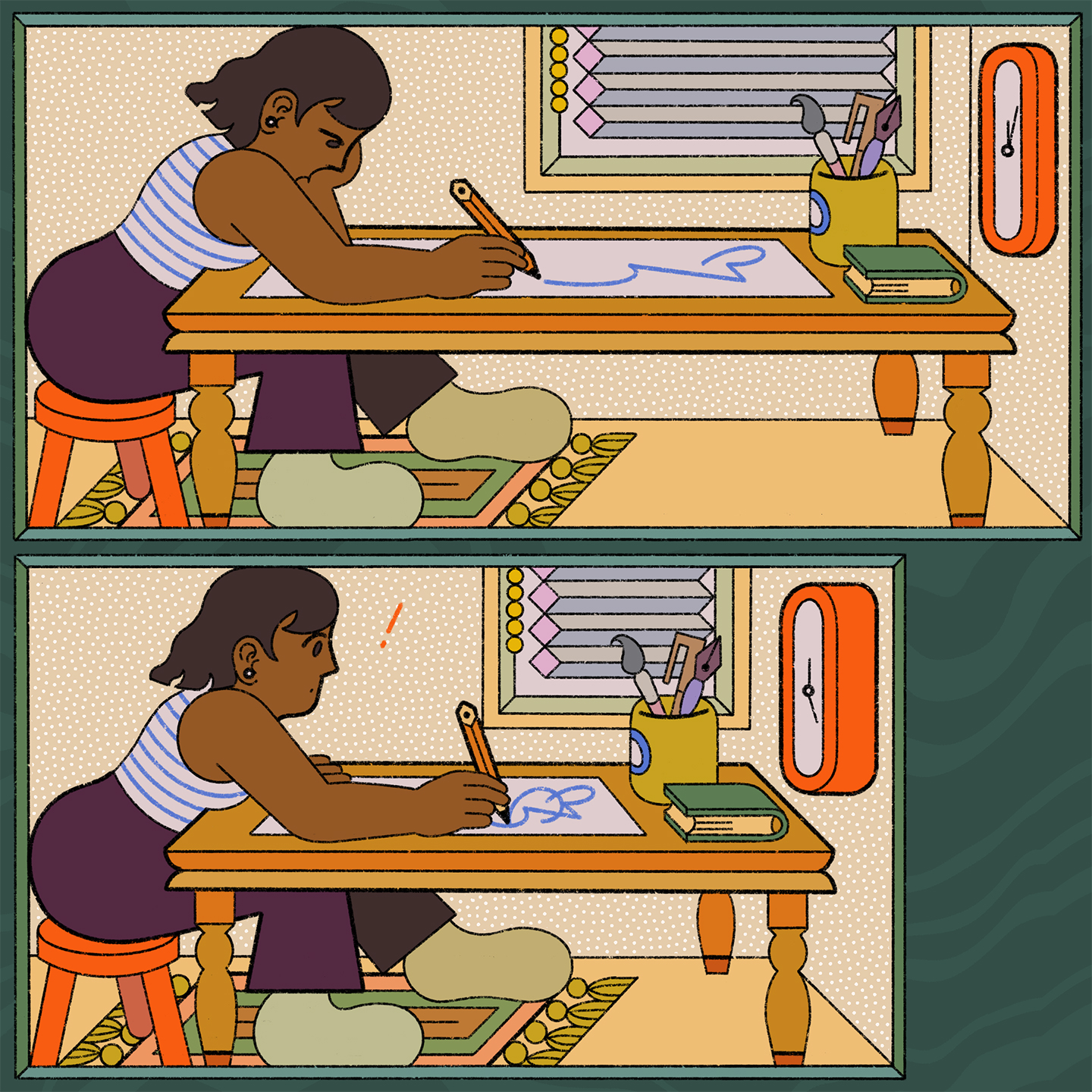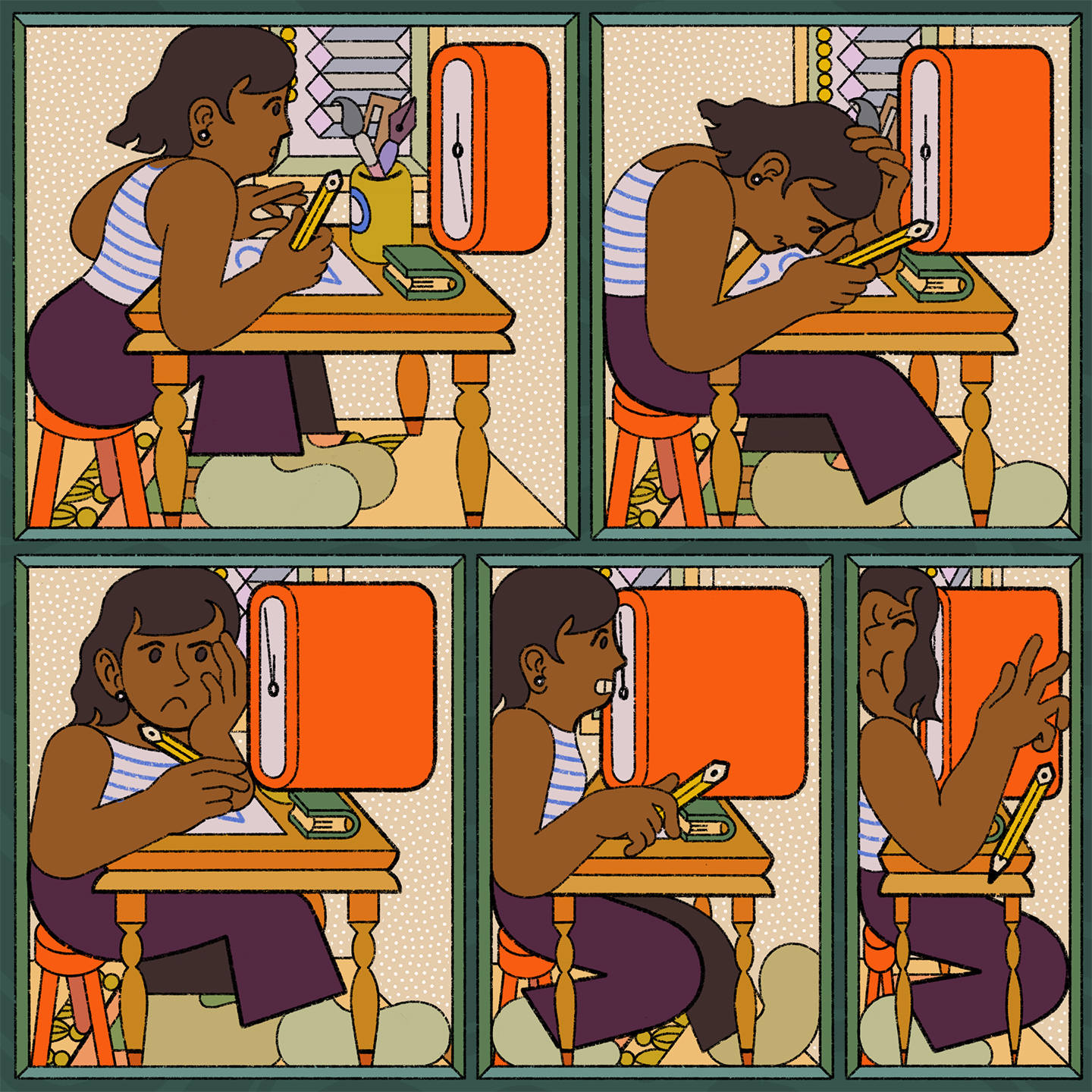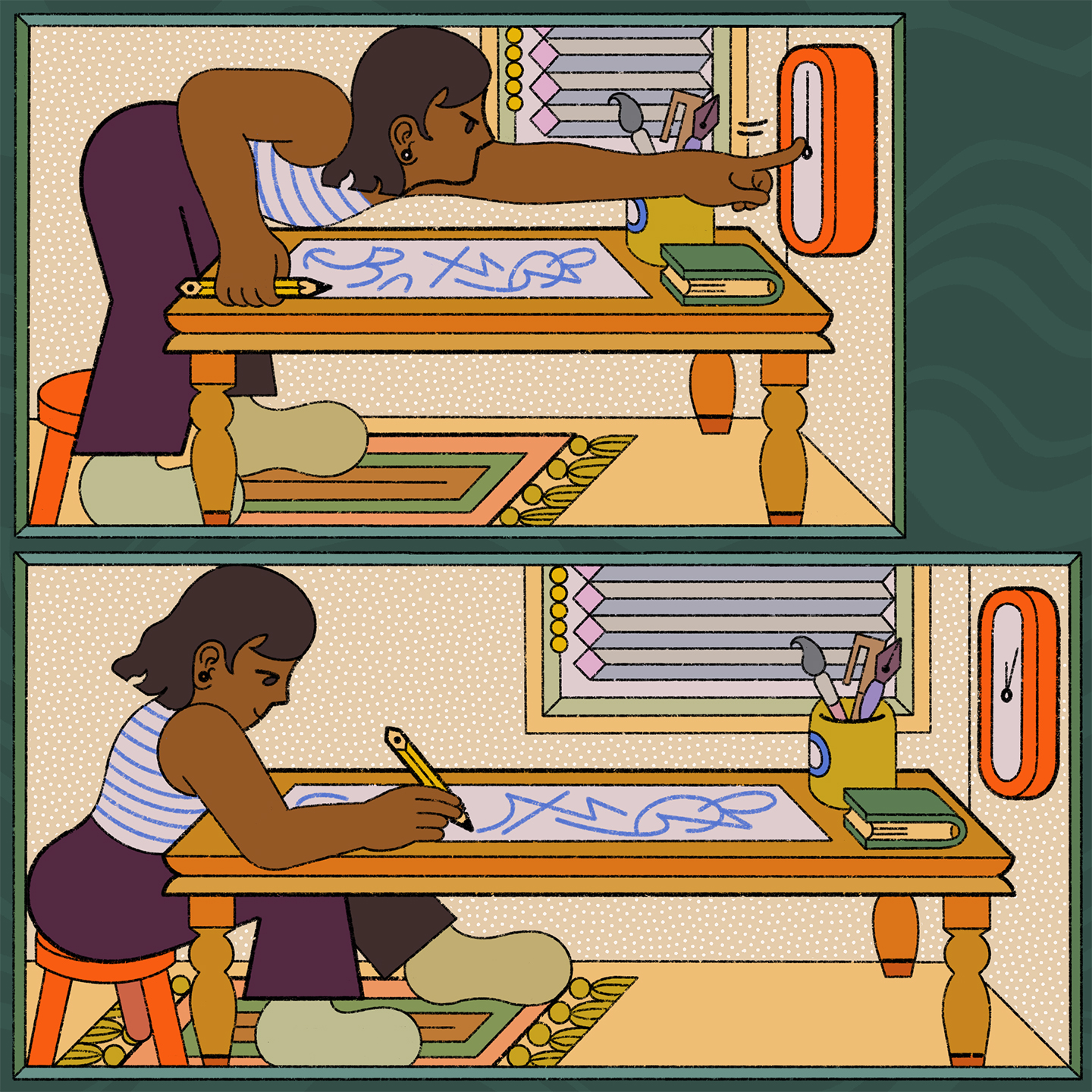03 Outwit Deadlines
Managing deadlines isn’t the little black dress of the creative process; it’s more like the trusty old sneakers that carry you across the finish line. By structuring your time smartly, you build a solid foundation that allows those flashy moments to truly shine, like unveiling a near-final draft to your client—on time. Without a clear timeline, you might risk running completely off course.
At Airbnb, the Creative Team engages in projects with international colleagues and talented freelancers around the world. Collaborating across time zones has taught us the importance of a clear and thoughtful timeline, especially when a project has a quick turnaround. By clarifying timing-related needs for both parties, you can prevent a host of logistical hiccups down the line.
Only 24% of illustrators think their clients understand timelines around creating illustrations. In this section of Tyrus, we’ll show you how to create a realistic timeline, and then communicate that timeline to your clients. We hope this helps you approach future projects with the same confidence you’d get from wearing that little black dress, tuxedo, or comfy sweatpants.
- Create a structured, well-ordered timeline
- Navigate tight turnarounds
- Educate clients on the time you’ll need to produce your best work
- Gain insights from the larger industry and Airbnb Design
Only ¼ of illustrators think their clients understand timelines needed to create an illustration.
How to Navigate a Tight Timeline Warm Up
This section of Tyrus focuses on a challenge many illustrators know all too well: the tight turnaround. At Airbnb, we understand—from both sides of the client/illustrator relationship—how hard it can be to meet each person’s needs on a fast-moving project. To help you avoid the common issues that arise along the way, we dove into five tight-timeline tips that we swear by—and that as clients ourselves, have come to appreciate. (Need help communicating with clients about a topic below? See our timeline and email templates for more guidance.)
How to Navigate a Tight Timeline
01 If a timeline seems too tight, speak up—and explain why.
As an illustrator, your job isn’t simply to draw. You also need to take time to get to know your client and their style. If the schedule you’ve been given doesn’t account for the time needed to do this properly, say so—but be sure to clarify why added time will help. Similarly, if you’ve been asked to create an illustration in 24 hours with a level of complexity that would normally take a week, explain which time frames are required for different kinds of illustrations. Sometimes, a little context is all that’s needed to convince a client to extend a deadline, or to switch to a simpler execution.
02 Get realistic about revisions.
In some cases, clients may set deadlines without considering the time needed for revisions. Remind them that the less time you have, the fewer opportunities there will be to ask for changes. If deadlines are set in stone, ask whether they’ll be able to provide same-day feedback so that your work stays on schedule.
03 Think strategically.
Before you put pencil to paper, take a moment to plan ways of maximizing efficiency. Strategies for streamlining include creating in-depth write-ups and moodboards, and getting hyper-specific about details early in conversations with your clients. The more you can do before the clock starts, the less stress you’ll feel when time’s running short.
04 Course-correct along the way.
Sometimes, despite your best efforts, you’ll find yourself needing more time than originally planned. When this happens, remember that frequent communication and honesty go a long way. Fill your client in on any delays as early as possible, and tell them why an extension will help you produce your best work. (Offer an out, too, in case a change in the plan isn’t possible—here’s how.)
Takeaway
Your needs are important—let them be known! Some clients will have hard-and-fast requirements when it comes to timing, but others may be willing to adjust. The key is to be clear about your needs up front, and you’ll pave the way for smoother collaboration.
Creating a Timeline That Works for Everyone Deep Dive
We asked illustrators to describe the pain points they encounter most when working with clients. The line we received over and over? “There’s never enough time.”
As illustrators, we want to deliver our best work possible. Something we know—but that clients may not understand—is that achieving that goal requires time and effort. Clients often assign a deadline with no knowledge of what it takes to complete an illustration, or without considering the time you’ll need to fully understand their vision. In scenarios like these, you have two choices: One is to accept the deadline, and with it, the stress of a tight turnaround. The other is to advocate for the time you need to complete your work successfully (and with sanity intact). The following Deep Dive shows why and how to choose the latter.
The Problem
A meal-prep delivery service aiming to expand their social branding is looking for illustrations that depict the concept of “learning through food.” Each month, they plan to highlight a different world cuisine to educate and inspire clients, and need artwork to support that vision. The job sounds fun and pays well, but the client needs finished illustrations for a feature on Burmese food by the end of the week. You’re hesitant to turn down the offer, but worry that you won’t be able to deliver quality work in such a short period of time.
The Solution
Step 1: If a timeline seems too tight, speak up—and explain why.
There’s one essential detail that clients consistently forget to factor into a production schedule, and that’s the time it takes for illustrators to understand their client’s needs and ideas. When time isn’t set aside for this to happen, the likelihood of a disorganized revision stage spikes, putting the entire timeline at risk of running off-schedule.


How this could go wrong
Even projects with thorough, strong briefs can veer off course when there isn’t enough time for illustrators to develop on-brand storytelling. To illustrate this fact, we conducted an experiment, asking two talented artists to follow the same brief from the delivery company mentioned above. Each was given 24 hours to complete a sketch for an invitation to learn more about Burmese food.
The illustrations we received interpreted the brief in two different ways. They were equally beautiful—but without time for a follow-up conversation after receiving the brief, both may have missed the mark when it came to meeting the client’s needs. What if the client specifies later that they were hoping to feature a less popular Burmese dish, or were looking for an illustration in a more maximalist style?—something that would have taken you much longer than one day to complete.
These are issues that could easily be addressed with added time to discuss goals—but unfortunately, with a 24-hour turnaround, there isn’t room in the schedule to accommodate this need.

How to get it right
If a turnaround is unreasonably tight, ask for more time, but be specific about why it’s important. Unless you’re working with a client who’s well-versed in the ways illustrators work, you’ll have to be the one to explain why certain processes are necessary. Don’t forget to mention that these benefit your client as much as they do you. The more time you’re given to create quality work (and to fully understand their needs), the more powerful the final product will be. After that, if a client still insists on a quick turnaround, clarify which styles would work best to meet their deadline. Our timeline template can help!
Step 2: Get realistic about revisions.
We’ve learned that illustrators often struggle when clients set deadlines without accounting for the time that the revision process will take. It’s important to let clients know that rushing through this crucial stage means fewer opportunities to make changes. And that if a deadline can’t be adjusted, measures will need to be taken to ensure that a drawn-out feedback cycle won’t throw the project off track.
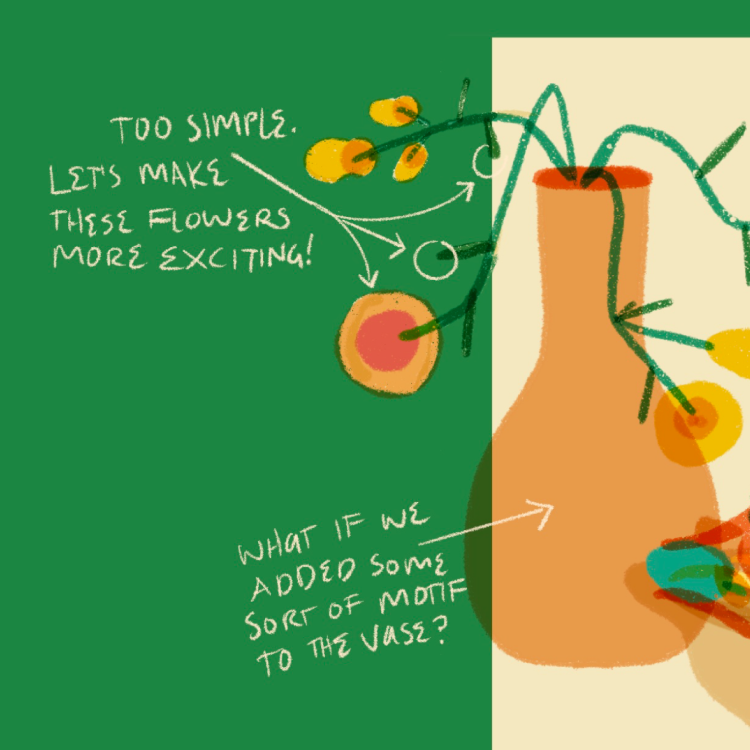
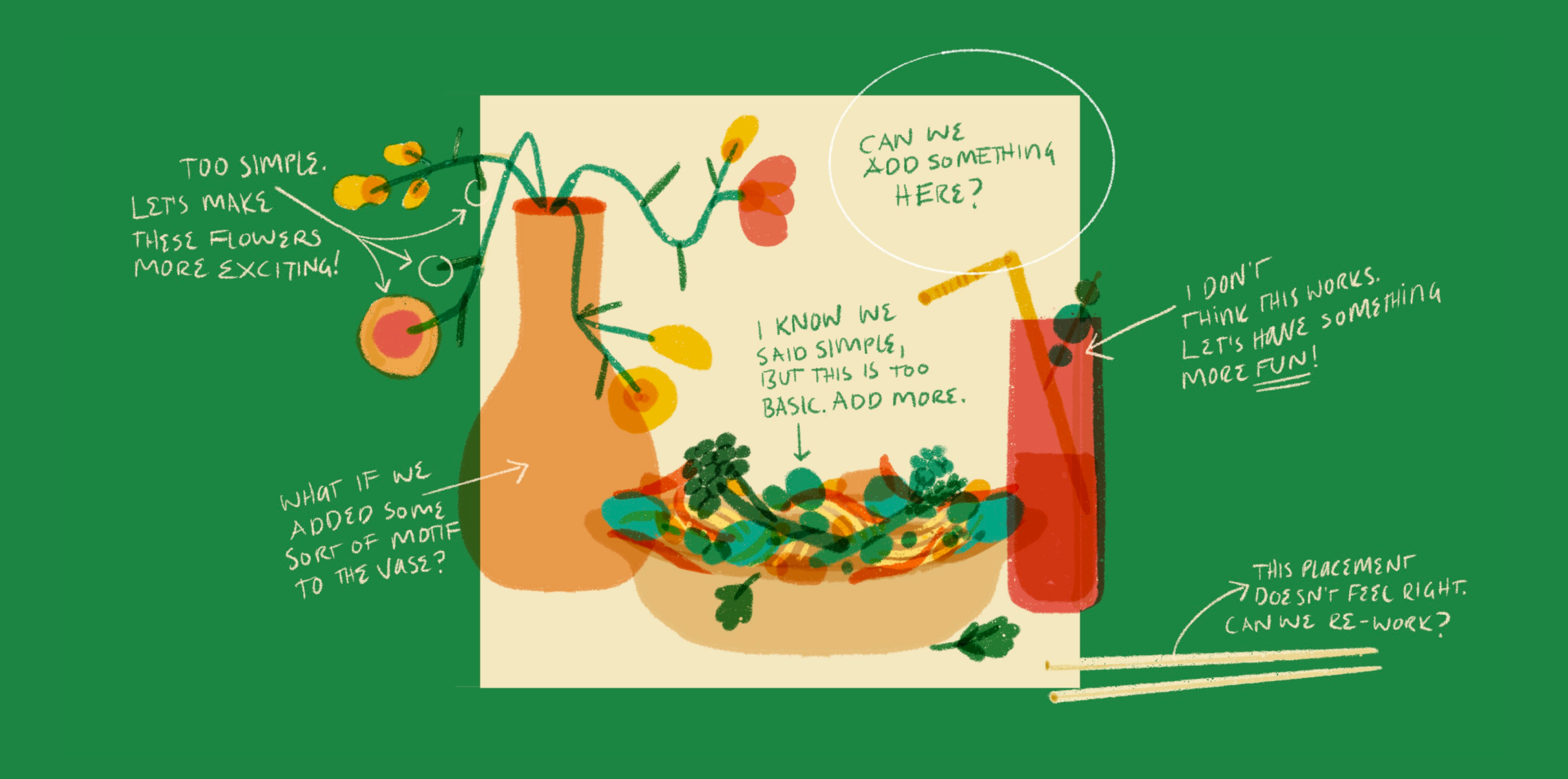
How this could go wrong
Your client asks for same-day revisions on the next draft of your illustration, but it’s taken them more than eight hours to corral feedback from key stakeholders. Now, you’re left with only a few hours to complete a task you’d originally expected would take closer to a full day.

How to get it right
Remind your client that tight timelines are a two-way street that require both of you to respect the agreed-upon deadline. Consider requesting the following during this conversation:
-
Capped revisions:
When timing is tight, limit revision cycles to one round only. -
A single stakeholder:
When one person is responsible for delivering feedback, it puts the responsibility of condensing multiple opinions on the client, rather than on you. -
Same-day feedback:
Same-day feedback can help keep a project on-course, but keep in mind that clients sometimes forget that gathering input from multiple stakeholders can take time. Make sure everyone knows when they need to be ready to offer comments, so there won’t be any unexpected hold-ups.
Lastly, make sure you have a clear understanding of what will happen if your client fails to stick to the terms you’ve decided on. Will it mean an extended timeline? An increased fee? Be as clear as you can about what will happen if they can’t hold up their end of the bargain.
Step 3: Think strategically.
Sometimes it isn’t an option to turn down a project based on timeline, for financial reasons or otherwise. Most freelancers have found themselves in situations where they need to make the best of what’s being offered. Know that when those instances arise, there are still ways of advocating for your needs. The more you align with your client before starting, the better your chances of making that deadline work!


How this could go wrong
Panicked about your looming deadline, you dive into the project without doing any strategic prep work. You produce a detailed, near-complete sketch of a Burmese dish as a first step, hoping to start strong by creating as much work as possible right off the bat. The next day, your client lets you know that they were hoping for something with an entirely different composition, and asks if you’d be willing to do another round of sketches by tomorrow.

How to get it right
Save time and unnecessary stress by doing as much research and legwork as you can before getting started. Compile mood boards to get a clear sense of your client’s color needs. Over-communicate about details (if you’ll be depicting humans, for instance, check in with your client about who they want to feature—gender, race, age, clothing, etc.). Most importantly, don’t obsess about early work being perfect. Instead of starting with detailed drawings, keep your early sketches loose and focus instead on nailing the high-level concept. Want to go the extra mile? Provide a strong write-up explaining your approach to each sketch.
Step 4: Course-correct along the way.
Sometimes, no matter how hard you’ve tried, it’s impossible to meet a deadline. It can be scary to let your client know that a project is off track, but being upfront early on will help them make an informed decision about next steps. It’ll also go a long way in preserving your professional reputation.


How this could go wrong
You’re moving forward with illustrations for your food delivery client, but two days before your deadline, you realize you’ll need extra time for color. You weigh your options and decide to pull an all-nighter in order to finish in time. Unfortunately, your due date arrives and the work is still only partially finished. Now, you find yourself in the difficult position of having to choose between submitting an incomplete illustration or asking for additional time at the last minute. Neither option is ideal, and both threaten to tarnish the relationship you’ve established with your client.

How to get it right
If a project is veering off schedule, determine how much extra time you’ll need and let your client know right away. Be sure to tell them what you’ll be able to accomplish if granted an extension, and why this would be beneficial to them in the long run. For example, explain that with an additional 48 hours, you’ll be able to meet their requirements around color, guaranteeing an extra-polished piece.
Of course, your client may not have the wiggle room to grant that extension, but the most important takeaway here is not to let fear and embarrassment stand in the way of clear communication. At Airbnb, we’re much more likely to work again with an illustrator who misses a deadline if they’re open with us about it early on. Snags in scheduling happen to the best of us—more often than not, we’re able to find a solution that works for everyone.
Conclusion
If you find yourself struggling to meet an unreasonable deadline—or if a project just isn’t going according to plan—remember to be gentle on yourself. Also, keep in mind that one of the biggest gifts you can give yourself is to learn to ask for the time you need. Remember that this is something that won’t just serve you. Your work will be made stronger, and your client happier, when you’re properly equipped to create your best work.


